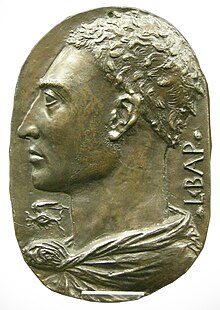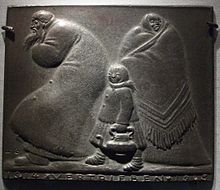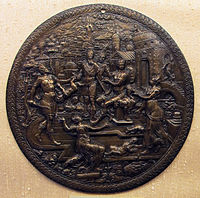Plaquette


A plaquette (French:
The form began in the 1440s in Italy, but spread across Europe in the next century, especially to France, Germany and the Low Countries. By about 1550 it had fallen from fashion in Italy, but French plaquettes were entering their best period, and there and in Germany they continued to be popular into the 17th century. The form continued to be made at a low level, with something of a revival from about 1850.[4] They have always been closely related to the medal, and many awards today are in the form of plaquettes, but plaquettes were less restricted in their subject-matter than the medal, and allowed the artist more freedom.
Usage
The purpose and use of decorative plaquettes was evidently varied and remains somewhat unclear; their creation and use is relatively poorly documented. Some were mounted in furniture, boxes or other objects such as lamps, and many examples have holes for hanging on walls, added later. Other copies have three or four holes, for holding in a setting. Religious subjects in a pair or set might be set into the doors of
often of designs that are also found in metal.Plaquettes were also collected, and in particular 16th-century examples are often crowded with figures, making the scenes hard to read. They are best appreciated when held in the hand near a good light source, and were probably passed round when a collection was shown to fellow connoisseurs. The difficulty of reading the scenes, and an often obscure choice of subjects, suggest that a self-conscious display of classical learning was part of their appeal, for collectors and artists alike. They were one of the types of objects often found in the – normally male – environment of the
The artists who made them tended to be either sculptors in bronze, also making small figures and objects such as inkwells, or
Plaquettes, like
-
Pax with plaquette by Valerio Belli
-
Ecce Homo, one of a set of four, for an inkpot or similar object
-
Two small plaquettes by Riccio used in a dagger hilt
-
Another view
Materials and technique

As with medals, Renaissance plaquettes were normally made using the
In early 16th-century Nuremberg, which was the main German centre,[13] plaquettes, like other metalwork types of objects, were often made in the relatively plebeian material of brass, even by top artists like the Vischer family and Peter Flötner.[14] Lead was also used, especially in German castings intended as artisan's models rather than for collectors.[15] From the 19th century on cast iron was also used, especially in Germany. In Italy lead was also used for an initial trial cast. The castings were normally not worked much further with tools, beyond polishing and often giving an artificial patina.[16]
History
The word plaquette is a 19th-century invention by the French art historian Eugene Piot. Les Bronzes de la Renaissance. Les Plaquettes by Émile Molinier of 1886 was the first large study, and these two between them defined the form as it is understood today.[17] To Renaissance Italians plaquettes were known, along with other similar types of objects, by a variety of somewhat vague terms such as piastra and medaglietti,[18] rilievi,[19] or modelli.[20]
Italy

Plaquettes grew from two rather different Italian origins. In Rome in the 1440s and 1450s they began as a way of reproducing the designs of classical engraved gems, by taking a wax impression of them. The Venetian Pietro Barbo (1417–1471) became a cardinal when his uncle was elected
Around the same time north Italian artists began making plaquettes, often much larger and with religious subject matter.
Significant later artists included
-
Knight attacked by three lions, Italian, c. 1465
-
Moderno, Battle of Cannae, 1503–04
-
Valerio Belli, Christ Carrying the Cross, 1530–50
Germany
German production began in Nuremberg, around 1500, but by 1600 Augsburg was the main centre. German examples tended to draw their designs from prints, and were in turn frequently reused in other media, and perhaps more often produced primarily as models for other trades. The repeated reuse of moulds, and their distribution far from their place of making, are especially typical of south German plaquettes. Even fewer of the artists involved are known than in Italy.[34] Production lasted well into the 17th century, when it became involved in the "Dürer revival", with several of his prints being turned into plaquettes.[35]
-
Master of the Heroic Antique Legends, Justice of Trajan, 1525–50
-
Georg Labenwolf, Hunt for hares, c. 1550
-
Workshop ofHans Jamnitzer, Judgement of Solomon, c. 1575
-
Caspar Enderlein, Europe, 1610–11
France and the Netherlands
Further north plaquettes were produced from around 1550, initially under influence more from Germany than Italy. Artists (often
-
Venus, Mars and Cupid, c. 1590
-
Marie de' Medici, 1600–10
-
Allegory of Spring and Summer, 1600–10
-
Low Counties, hunting scene, 17th century
Later history

The form saw a small revival in the 19th century; examples from this period are typically rather larger than in the Renaissance. Artists such as, in America, Augustus Saint-Gaudens and Emil Fuchs made commemorative portrait plaquettes of figures such as Leo Tolstoy and Mark Twain (both by Saint-Gaudens).[37] Especially in France and Germany, commemorative plaquettes for industry and institutions involved a wide range of contemporary subject matter. A number of artists produced examples purely because they were attracted by the form, or the possibility of reaching a wider market. A number of regular awards by institutions chose the plaquette form, though often retaining "medal" in the name of the award. The circular so-called "death penny" (the Memorial Plaque) minted in the UK after World War I is a large twentieth-century commemorative example.
Collections

Many major museums have collections, which are not always given room in the gallery displays. The National Gallery of Art in Washington D.C., despite being essentially a collection of paintings, has what is recognised as the finest single collection, especially of Italian Renaissance work, which includes over 450 plaquettes,[38] and is very well displayed on the ground floor.[39]
The Washington collection of medals, plaquettes and small bronzes includes the leading French collection assembled by Gustave Dreyfus (1837–1914), which was bought by Samuel H. Kress (1863–1955). In 1945 the Kress Foundation added over 1,300 bronzes collected by the British art dealer
The
The
See also
- Royal Copenhagen 2010 plaquettes – modern ceramic examples
- Commemorative plaque
Notes
- ^ Wilson, 97
- ^ Palmer, 74; Grove, 220
- ^ Grove, 222
- ^ Grove, 220–223
- ^ Palmer, 73
- ^ Wilson, p.8 and various entries, Grove, 220–223
- ^ Marks, 40
- ^ Wilson, p.8, Grove, 220, 222; Syson and Thornton, 78–91 for a wider context
- ^ Grove, 220–222
- ^ Hayward, 779
- ^ Grove, 220, 222
- ^ Grove, 220–223
- ^ Grove, 222
- ISBN 0870994662, 9780870994661, google books
- ^ Hayward, 779
- ^ Palmer, 75
- ^ Warren, 833
- ^ Grove, 220; Syson and Thornton, 117
- ^ Syson and Thornton, 117 ("reliefs")
- ^ Palmer, 74
- ^ Grove, 220–221
- ^ Palmer, 75
- ^ Wilson, 12
- ^ Palmer, throughout; Wilson, 14; Grove, 221
- ^ Palmer, 76–78
- ^ Wilson, 14–24
- ^ Wilson, 105–110; Grove, 221
- ^ Wilson, 76–88
- ^ Wilson, 111–113
- ^ Wilson, 114–116
- ^ Wilson, 127–133
- ^ Grove, 221–222; Wilson, 111–116
- ^ Grove, 221–222; Wilson,76–88
- ^ Hayward, 779–780; Grove 222
- ^ Grove, 222
- ^ Grove, 222
- ^ Gardner, Albert Ten Eyck, American Sculpture: A Catalogue of the Collection of the Metropolitan Museum of Art, pp. 92–94, 1965, Metropolitan Museum of Art (New York, N.Y.)
- ^ Wilson, 6
- ^ Grove, 220; Wilson is the handbook for this collection
- ^ Wilson, 6
- ^ Bober, 593
- ^ Warren, 833
References
- Bober, Phyllis Pray, review of Italian Plaquettes by Alison Luchs, Renaissance Quarterly, Vol. 44, No. 3 (Autumn, 1991), pp. 590–593, The University of Chicago Press on behalf of the Renaissance Society of America, Article DOI: 10.2307/2862612, JSTOR.
- "Grove": "Plaquette" in ISBN 0195189485, 9780195189483, Google books.
- Hayward, J.F., review of Deutsche, Niederländische und Französische Plaketten 1500–1650, 2 Vols by Ingrid Weber, The Burlington Magazine, Vol. 118, No. 884 (Nov., 1976), pp. 779–780, JSTOR.
- Marks, P.J.M., Beautiful Bookbindings, A Thousand Years of the Bookbinder's Art, 2011, British Library. ISBN 978-0-7123-5823-1.
- Palmer, Allison Lee, The Walters' "Madonna and Child" Plaquette and Private Devotional Art in Early Renaissance Italy, The Journal of the Walters Art Museum, Vol. 59, Focus on the Collections (2001), pp. 73–84, The Walters Art Museum, JSTOR.
- ISBN 0892366575, 9780892366576, google books.
- Warren, Jeremy, Review of Placchette, secoli XV-XVIII nel Museo Nazionale del Bargello by Giuseppe Toderi, The Burlington Magazine, Vol. 138, No. 1125 (Dec., 1996), pp. 832–833, JSTOR.
- Wilson, Carolyn C., Renaissance Small Bronze Sculpture and Associated Decorative Arts, 1983, National Gallery of Art (Washington). ISBN 0894680676.
Further reading
- Studies in the History of Art, Vol. 22, Symposium Papers IX: Italian Plaquettes (1989).
External links
- European sculpture and metalwork, a collection catalogue from The Metropolitan Museum of Art Libraries (fully available online as PDF), which contains material on plaquettes (see index).



















